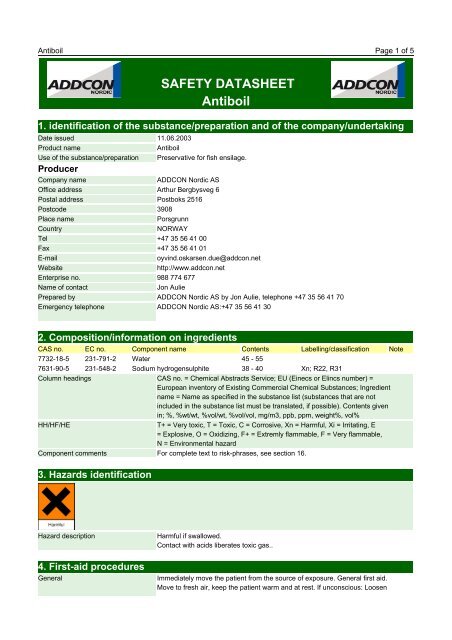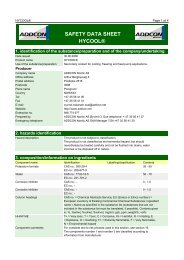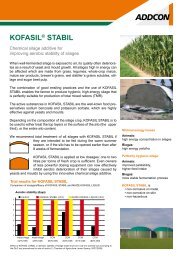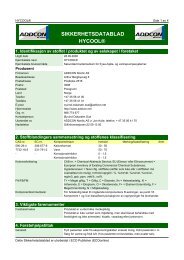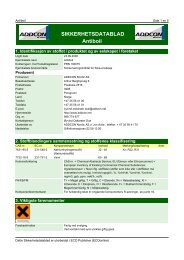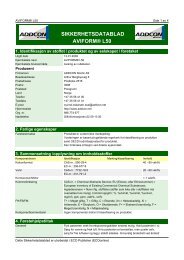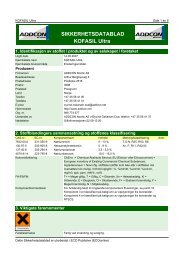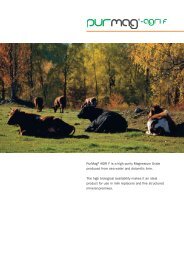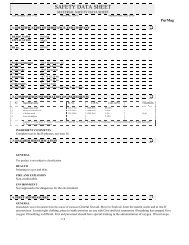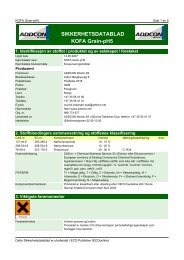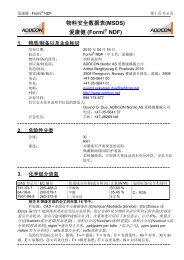SAFETY DATASHEET Antiboil - Addcon
SAFETY DATASHEET Antiboil - Addcon
SAFETY DATASHEET Antiboil - Addcon
You also want an ePaper? Increase the reach of your titles
YUMPU automatically turns print PDFs into web optimized ePapers that Google loves.
<strong>Antiboil</strong> Page 1 of 5<br />
<strong>SAFETY</strong> <strong>DATASHEET</strong><br />
<strong>Antiboil</strong><br />
1. identification of the substance/preparation and of the company/undertaking<br />
Date issued 11.06.2003<br />
Product name <strong>Antiboil</strong><br />
Use of the substance/preparation Preservative for fish ensilage.<br />
Producer<br />
Company name ADDCON Nordic AS<br />
Office address Arthur Bergbysveg 6<br />
Postal address Postboks 2516<br />
Postcode 3908<br />
Place name Porsgrunn<br />
Country NORWAY<br />
Tel +47 35 56 41 00<br />
Fax +47 35 56 41 01<br />
E-mail oyvind.oskarsen.due@addcon.net<br />
Website http://www.addcon.net<br />
Enterprise no. 988 774 677<br />
Name of contact Jon Aulie<br />
Prepared by ADDCON Nordic AS by Jon Aulie, telephone +47 35 56 41 70<br />
Emergency telephone ADDCON Nordic AS:+47 35 56 41 30<br />
2. Composition/information on ingredients<br />
CAS no. EC no. Component name Contents Labelling/classification Note<br />
7732-18-5 231-791-2 Water 45 - 55<br />
7631-90-5 231-548-2 Sodium hydrogensulphite 38 - 40 Xn; R22, R31<br />
Column headings CAS no. = Chemical Abstracts Service; EU (Einecs or Elincs number) =<br />
European inventory of Existing Commercial Chemical Substances; Ingredient<br />
name = Name as specified in the substance list (substances that are not<br />
included in the substance list must be translated, if possible). Contents given<br />
in; %, %wt/wt, %vol/wt, %vol/vol, mg/m3, ppb, ppm, weight%, vol%<br />
HH/HF/HE T+ = Very toxic, T = Toxic, C = Corrosive, Xn = Harmful, Xi = Irritating, E<br />
= Explosive, O = Oxidizing, F+ = Extremly flammable, F = Very flammable,<br />
N = Environmental hazard<br />
Component comments For complete text to risk-phrases, see section 16.<br />
3. Hazards identification<br />
Hazard description Harmful if swallowed.<br />
Contact with acids liberates toxic gas..<br />
4. First-aid procedures<br />
General Immediately move the patient from the source of exposure. General first aid.<br />
Move to fresh air, keep the patient warm and at rest. If unconscious: Loosen
<strong>Antiboil</strong> Page 2 of 5<br />
tight clothing, place in stable position on one side. Give artificial respiration if<br />
breathing has stopped. Contact a physician.<br />
Inhalation See "General". If any sign of loosing consciousness or discomfort, summon<br />
physician.<br />
Skin contact Immediately remove contaminated clothing and flush skin with copious<br />
amounts of water. Summon physician if discomfort persists.<br />
Eye contact Flush with large amounts of water (open eyelids) for at least 15 minutes.<br />
Continue flushing until physician takes over. It is important that the flushing is<br />
not discontinued too early.<br />
Ingestion Do no induce vomitting! Rinse mouth with water and give 1 glass of water or<br />
milk to drink. Get medical advice quikcly!!<br />
5. Firefighting measures<br />
Suitable extinguishing media Use extinguishing media appropriate for surrounding fire.<br />
Improper extinguishing media The product is not flammable. Heating to decomposition will form toxic gas of<br />
sulphur dioxide (SO2)<br />
Personal protective equipment Generally: Evacuate all persons. Wear complete protective suit for fire<br />
extinguishing. Use self-contained breathing apparatus and full protective gear<br />
when the product is involved in fire.<br />
Other Information The fire should be extinguished from a safe place.<br />
Containers exposed to flames can be cooled with water. Move containers if<br />
possible without any risk.<br />
6. accidental release measures<br />
Personal precautions Ensure good ventiation. Avoid contact with eyes and skin. Use appropriate<br />
protective equipment, see section 8<br />
Environmental precautions Avoid emissions of considerable amount to water or drains. Inform appropriate<br />
authorities if large amounts are involved.<br />
Methods for cleaning Spillage may be pumped up or absorbed with dry, inert material such as<br />
sand, earth etc. Place in suitable containers. Label containers with the name<br />
and composition of the product. Dispose of in accordance with local<br />
regulations for waste handling (see section 13).<br />
7. handling and storage<br />
Handling Ensure good ventiation. Avoid contact with eyes and skin. Use appropriate<br />
protective equipment: Neoprene gloves, gas mask with cartridge E (yellow) at<br />
low vapour concentrations. High exposure: Use supplied air respirator. Wear<br />
approved goggles or face shield if there is a possibility of splashes. Wear<br />
protective clothing, preferably of neoprene material.<br />
Storage Store in a dry, cool place in tightly closed containers.<br />
Smaller plastic containers should be tightly closed while lagre containers of<br />
stainless steel or plastic should be ventillated from the highest point. To be<br />
stored in a cool place (temperature not below -10 ºC) and in a well<br />
ventilated place. Stable if correct storage conditions.<br />
8. exposure controls/personal protection<br />
Exposure limit values<br />
CAS no. EC no. Component name TWA (8h) ppm/mg/m3
<strong>Antiboil</strong> Page 3 of 5<br />
All protective equipment should be labelled with CE.<br />
Wash hands after working with the product.<br />
Respiratory protection Wear gas mask with cartridge E (yellow) at low vapour concentrations. Check<br />
that mask fits tightly and change filter regularly. High exposure: Use supplied<br />
air respirator.<br />
Hand protection Wear protective gloves of neoprene. Penetration time is not tested for this<br />
material, change gloves often. The penetration time might vary with exposure<br />
time, the type of work and the thickness of the glove material.<br />
Eye protection Wear approved goggles or face shield if there is a possibility of splashes.<br />
Skin protection (other than of the Wear protective clothing, preferably of neoprene material.<br />
hands)<br />
9. physical and chemical properties<br />
Physical state Liquid<br />
Odour Pungent<br />
Colour Yellowish<br />
Solubility in water Soluble<br />
Specific gravity 1350 kg/m³<br />
Melting point/melting range -15<br />
Melting point/melting range Value: °C<br />
Boiling point 102<br />
Boiling point Value: °C<br />
pH (as supplied) 4,5 - 6,0<br />
Vapour pressure 4 v/ 20ºC<br />
Other physical and chemical properties<br />
Physical and chemical properties For Sodium Hydrogensulphite, a decrease in temperature for freezing point<br />
will occur with an increase in concentration until saturation point (43% at<br />
20ºC)<br />
10. stability and reactivity<br />
Materials to avoid Reacts with acids and forms a toxic gas - Suphur dioxide. May react<br />
violently with nitrates, nitrites, sodium sulphide and other oxidizing agents.<br />
Hazardous decomposition products Thermal decomposition (> 120 ºC) of evaporated solution, will form sulphur<br />
dioxide, eventually also disodium oxide (Na2O).<br />
11. Toxicological information<br />
Toxicological Information:<br />
Other toxicological data LD 50 Oral (Rat) > 2000 mg/kg , regards the product in physical state as<br />
solid.<br />
Other information regarding health hazards<br />
Inhalation Upper respiratory irritation: Signs/ symptoms can include soreness of the nose<br />
and throat, coughing and sneezing. High concentration of vapours may give<br />
dyspnoea.<br />
Skin contact May cause irritation, redness, smarting and also dermatitis (non-allergic<br />
dermatitis).<br />
Eye contact Severe irritation, smarting and pain. Prolonged contact may cause burns.<br />
Ingestion Harmful if swallowed. Smarting in mouth and throath, abdominal pain,<br />
discomfort and vomitting. Sulphur dioxide (toxic) will be formed when the<br />
product reacts with gastric juice. Vomitting will cause risk of aspiration of the<br />
product to lungs. This may lead to chemical pneumonia.<br />
12. ecological information<br />
Toxicological Information:
<strong>Antiboil</strong> Page 4 of 5<br />
Aquatic, comments Do not bioaccumulate.<br />
Other ecological information<br />
Ecotoxicity LC fish (Mosquito fish) 24 h, 240 mg/L.<br />
EC 50 (Daphnia Magna) 96 h, 120 mg/L.<br />
Mobility Soluble in water.<br />
Bioaccumulative potential Do not bioaccumulate.<br />
13. disposal considerations<br />
EWC waste code 06 03 14: other solid salts and brines.<br />
Product classified as hazardous<br />
waste<br />
Yes<br />
Specify the appropriate methods of<br />
disposal<br />
Classified as hazardous waste.<br />
Waste must be treated properly. Empty containers must disposed of according<br />
to lokal regulations.<br />
Other Information The EWC-code above is instructive. The user has to find the appropriate<br />
code depending on the use of the product.<br />
14. Transport information<br />
Product name (national) Bisulphites, aqueous solution, n.o.s. (Sodium hydrogensulphite)<br />
UN no. 2693<br />
Dangerous goods ADR/RID No, Class:8, C1 Hazard no.:80<br />
Dangerous goods IMDG No, Class:8 Packing group:III<br />
Dangerous goods ICAO/IATA No, Class:8 Packing group:III<br />
Hazard label 8<br />
Other applicable information. Packing group ADR: III.<br />
IMDG: Ems F-A, S-B.<br />
15. regulatory information<br />
Hazard symbol<br />
Composition on the label Water: 45 - 55 %, Sodium hydrogensulphite: 38 - 40 %<br />
R phrases R22 Harmful if swallowed.<br />
R31 Contact with acids liberates toxic gas.<br />
S phrases S25 Avoid contact with eyes.<br />
S46 If swallowed, seek medical advice immediately and show this container<br />
or label.<br />
References (laws/regulations) Norwegian substances list (stoffliste) 2002 (Statens forurensningstilsyn,<br />
Arbeidstilsynet, Direktoratet for brann og eksplosjonsvern). (67/548 EC,<br />
appendix .1 with amendments 2001/58EEC)<br />
Norwegian occupational exposure limit values (Administrative normer for<br />
forurensning i arbeidsatmosfære, Arbeidstilsynet, best.nr. 361). (91/322/EEC,<br />
96/94/EC, 2000/39/EC)<br />
ADR, RID, IMDG, IATA.<br />
Micromedex Tomes CPS System.<br />
Classification and labelling of hazardous chemicals, (Statens<br />
forurensningstilsyn, Arbeidstilsynet, Direktoratet for brann- og elsikkerhet2002)<br />
(67/548/EC and 1999/45/EC)<br />
Hazardous waste (SFT 2003) (91/689/EC, 94/31/EC, 2000/532/EC,<br />
2001/118/EC, 2001/119/EC og 2001/573/EC)<br />
Guidelines for Health, Environment & Safety datasheets. (01.08.2002)
<strong>Antiboil</strong> Page 5 of 5<br />
16. other information<br />
List of relevant R-phrases (in<br />
section 2)<br />
Sources of key data used to<br />
compile the safety datasheet<br />
(91/155/EC, 93/112/EC, 1999/45/EC item 14, 2001/58/EC).<br />
R22 Harmful if swallowed.<br />
R31 Contact with acids liberates toxic gas.<br />
HES-datasheet and information from manufacturer<br />
Supplier's notes Issued according to information from maufacturer and HES-datasheet fram<br />
manufacturer.


